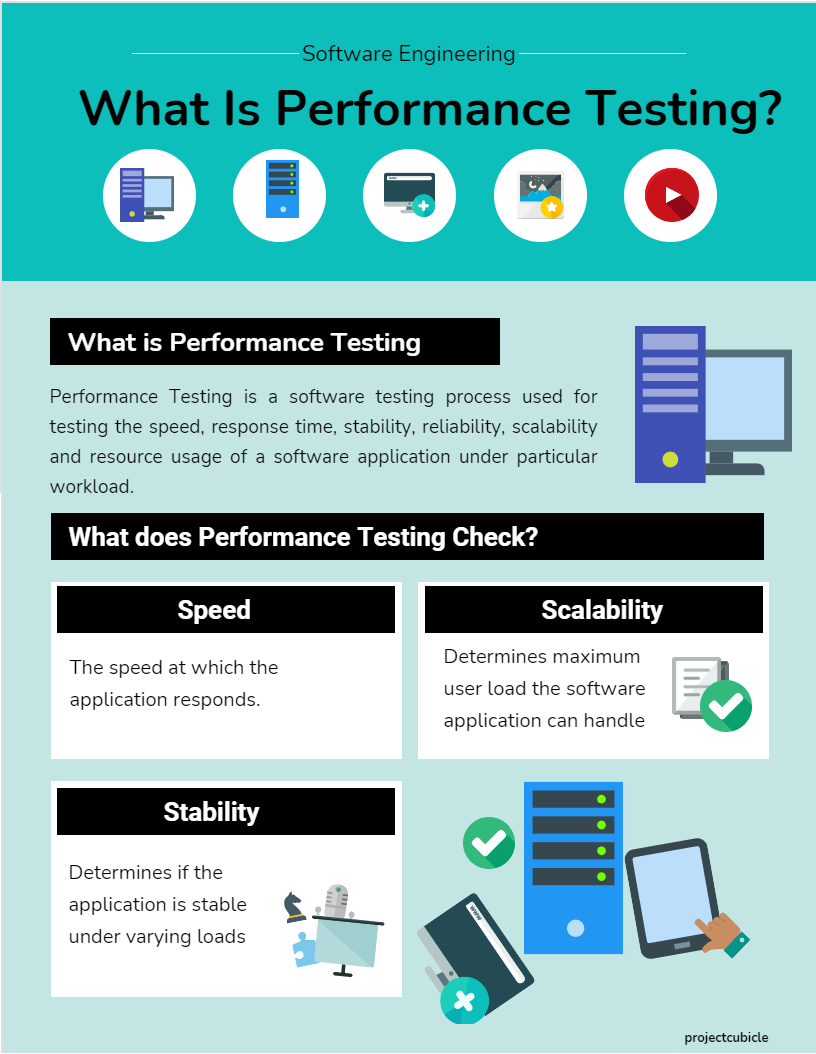Definition, Types, Process, and Advantages of Performance Testing in Software Engineering
With many helpful features and functionality, each new technology application is created. That being said, it is susceptible to usability, resource utilization, scalability as well as other considerations, regardless of how beneficial a new app is. If products are forwarded to the market with low performance indicators, their credibility will probably be weak as well as sales targets will also struggle. Therefore, the Performance Testing methodology employs processes and tools to check the performance parameters such as speed, response time, stability, reliability, etc. of a software application. Here we discuss the key advantages of Performance Testing in software engineering
Table of Contents
What Does Performance Testing Mean?
Performance testing is a test methodology that evaluates a particular software’s pace, usability, and stability behind a particular task. It makes sure product consistency and prepares the system for commercial release. Performance tests are a test measurement, which measures CPU, computer, software or system speed, usability, and consistency under a scenario. So as to recognize success-related bottlenecks, organizations conduct performance assessments. Without even any sort of checking the requirements of the system, delayed reaction times and inaccurate feedback seen between consumers as well as the system software are likely to have an impact it and create a global bad user experience. Defining if the device built satisfies speed, reactivity and reliability needs when working would assure a more positive practice for the customer.
- Speed– The rate of reactivation of the program.
- Scalability – The applications’ full usage load.
- Stability – the system state under different loads.
Different Kinds of Performance Testing
There are several categories of usability tests that are dependent on various criteria to learn how software can do after it connects to the internet. Many of the most often found are below;
- Volume testing – Volume testing aims primarily at checking program consistency in multiple data capacities. The software’s behavior is tracked by adding different huge data to the server.
- Stress testing – the primary purpose of stress testing is the discovery of a software application’s principal breaking point. This is achieved by checking the framework for heavy traffic or data collection under a very increased workload.
- Spike testing – The key goal of spike testing is to measure the software’s response when a big sharp increase (user-generated) happens at a charge.
- Scalability testing – Scalability testing mostly focuses on determining whether the program can efficiently scale back in the midst of user overrun. One such test often lets you prepare to increase capacity to other specific uses.
- Load monitoring – The primary goal of load testing is to find delays in output or even the willingness of its program to function by expected users.
- Endurance tests – The device can withstand the anticipated load for a while by conducting durability tests.
The Process of Performance Testing
The performance testing methods can vary significantly with various companies, but the goal is the same. This is a standard seven-step method for performing efficiency tests.
Step 1: Identify the environmental testing
The learning environment or the strongest testing process is where the goodness occurs. Define the testing environment and know which test methods are available. Realize in advance the specifics of both the equipment, applications and various network settings.
Stage 2: Define indicators of results
It is also necessary to define the quality success parameters as well as the general performance measures such as response time, productivity, and limitations. Sometimes, you do not define a sufficiently large range of success indicators. Related applications can be found which also succeed in determining output objectives.
Step 3: Performance planning and design testing
Identifies a variety of main situations with usage variance, evaluation results, and strategy success taken into consideration. This is possible to compare a number of uses as well as describe the measures to also be collected.
Step 4: Test Environment Configuration
Organize the appropriate research methods and tracking services prior to actually implementation to plan the compute cluster.
Step 5: Test Design Implementation
Model all assessments and as per the standards and measurements of results.
Step 6: Running the Tests
Run the results checks and run them. In addition, collect and track all the produced test results.
Step 7: Analyze, Tune, and then Retest
Following each test conducted, reassess the results and adjust the experiment to see better results or decline. Use the same or separate configurations to run the experiments again.
Advantages of Performance Testing
Performance testing methodology helps to demonstrate that your software system meets the required performance criteria. It is also used to make a comparison between the performance of two or more software. From this aspect, using performance testing tools provides many advantages to development teams.
Perhaps that the low output of your applications causes you to lose clients. There are some advantages of performance checking and why risk management is so critical for the application:
- Early problem identification and supports project managers in the detection of errors prior to publication
- Monitors application speed, stability, and precision in both normal situations and instituting
- Enhances client satisfaction by client retention measurements
- Affirms new computer’s quality attributes
- Enhances overall load efficiency and supports the structure
Testing Tools for Carrying out Performance Testing
There are several testing tools in the industry that are used to facilitate the software performance testing process. It is necessary to choose a method based on your criteria in order to obtain the best outcome with performance testing. The other most famous test methods are listed here.
LoadNinja
LoadNinja enables you to form both scriptless and sophisticated load tests in a very short time without making the quality any worse. Because it is scriptless, it gets rid of the necessity for script translation and scrubbing.
JMeter
JMeter is an open-source measurement platform for analyzing and measuring web application results.
HP LoadRunner
HP Stages of cancer are among the most effective methods to determine device output at extremely large things in near real-time.
WebLoad
For phone load checking, web load is used. It integrates all elements of performance monitoring in one site and phone development phase.
Bottom Line
Performance testing methodology is used to verify the software’s usability by several variables. The management of heavy traffic loads and the overcoming of other efficiency issues is essential for all organizations. There is also fierce competition for test experts with these qualifications. If you are interested to learn more, you can look and check the training programs on related topics in order to advance your career in the field such as automation test engineer.
The curriculum in this kind of training programs offer you full aspects of software functional testing tools and thus, allows you to build a stable test environment. You can simply begin to search for courses as soon as possible to increase the pace of developing your existing software career.
See Also
Edge Computing vs Cloud Computing

Over 20 years in portfolio management, streamlining business processes, and systems integration. Utilizing best practices: PMI, Scrum, Agile, Kanban, Lean/Six Sigma, CMMI, ITIL and MOF. Extensive experience in managing in cross functional environment, getting to the root of the problem, bringing stakeholders together to resolve them. Vice President at Force3M Training.










